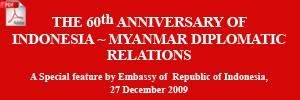HOUSE OF THE WEEK
Kamaryut duplex on offer as sale or rental
YOU can buy it or you can rent it, and it’s available at Hanthar Yeikmon housing project, just off Bayintnaung Road, about 25 minutes from downtown, and not far from the Hledan Junction and Thirimingalar market. moreUnderfunded Inle at risk: experts
(Volume 26, No. 520)

A fisherman clears algae from Inle Lake. Pic: Stuart Deed
LOCAL environmental groups have called on the government to increase funding for conservation activities at Inle Lake, the country’s most-visited ecotourism site.
Environmental experts say the low level of funding, which has remained unchanged since 2006, is putting the site’s future at risk.
They also called for increased cooperation between all stakeholders to preserve the 44.9-square-mile lake, which is famous for its bird and plant life, as well as the culture and customs of the different ethnic groups that inhabit the area.
“This is a very small amount [of funding] for these activities. We need to put more emphasis on preserving Inle Lake. If not, before we realise it we will have lost an important tourism and biodiversity site,” said U Win Myo Thu, managing director of local research non-government organisation ECODEV. “Additionally, there needs to be more cooperation between the government and the private sector, which also has an important role to play.”
He added that there was not enough funding to thoroughly clear algae from the most-frequented waterways of the lake, such as between Nyaungshwe and Phaung Daw Oo Pagoda, inhibiting transportation around the lake.
U Ohn, vice-president of the Forest Resource Environment Development and Conservation Association (FREDA), agreed cooperation was important for securing the lake’s future.
“Cooperation from the different fields is necessary. Inle Lake is still in relatively good condition, so getting things happening now is essential,” U Ohn said.
Central to the issue, experts say, is the lake’s human population. While tourism has brought many benefits to the region, it has also strained the local ecosystem by stimulating increases in both the number of temporary visitors and permanent residents.
There are now 13 hotels situated on Inle Lake with more than 300 rooms, and the population density on and around the lake has exploded to more than 1000 people per square mile, five times the average national population density.
Recognising its responsibility to preserve the lake’s natural environment, the Taunggyi Zone Hoteliers Association in 2009 began participating in environmental conservation activities.
“As the hoteliers association, we need to put more effort into conservation here. Inle Lake is one of the most important ecotourism sites and hotels rely mostly on foreign tourists for business. The association is working to raise public awareness among locals for the conservation of this region,” said U Aung Kyaw Moe, secretary of Taunggyi Hoteliers Association.
But Dr Moe Moe Dwe, an assistant professor in Loikaw University’s Botany Department, says most of the damage is inflicted by residents, rather than tourists.
“Most of the damage to the environment can be traced to the people who are living on the shore of the lake and in the villages on the lake. They throw rubbish into the lake and this leads to increased levels of silt and algae. Now the population density is increasing and the more it increases, the greater the negative impact on the environment,” Dr Moe Moe Dwe said.
He said the population density in the area had increased despite warnings from local authorities not to extend the human settlement area. “The local authorities need to take some firm steps to control this population explosion.”
U Win Myo Thu said a study conducted from 2004 to 2006 by ECODEV and the National Commission for Environmental Affairs showed the lake’s surface area had shrunk because land was being reclaimed for habitation and farming.
The water level is also presently lower than normal, a phenomenon experts also attributed to human factors.
U Win Myo Thu said deforestation along the edge of the lake was partly to blame, while U Aung Myint, the general secretary of the Renewable Energy Association Myanmar, attributed it to increased silt levels, following a research trip to the lake earlier this month.
“The water level of Inle Lake is low during this month because there is too much silt being deposited in the lake. Silt is often the result of human behaviour. We can manage this problem using machines to clean up the silt – if there is the funding to do so,” U Aung Myint said.










